Table of Contents
Adventurous Mice
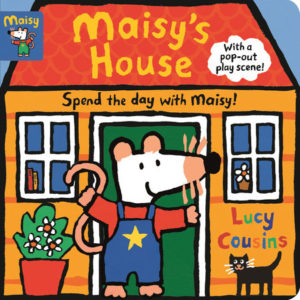 |
There are many picture books starring Lucy Cousins’s Maisy, an adventurous four-year-old mouse.
See Maisy for info and games for kids. |
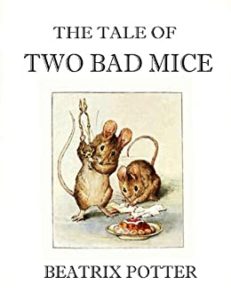 |
In Beatrix Potter’s The Tale of Two Bad Mice (Warne, 1996), the mice vandalize a dollhouse – but they’re sorry later. For ages 3-6. |
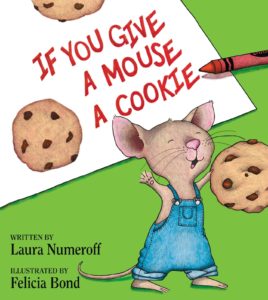
|
Laura Numeroff’s If You Give a Mouse a Cookie (HarperCollins, 1985) is a giggle-provoking chain of disasters. A persistent and adorable mouse wants a cookie, then demands a glass of milk, then a straw, then a boost to the mirror to see if he has a milk mustache… all with increasingly awful messy consequences. There are many sequels in the same vein, among them If You Give a Pig a Pancake, If You Give a Moose a Muffin, and If You Give a Cat a Cupcake. For ages 3-7. |
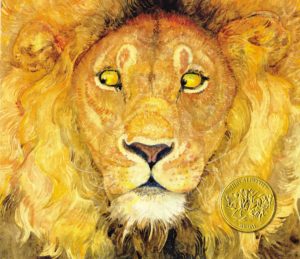
|
Jerry Pinkney’s The Lion and the Mouse(Little, Brown Books for Young Readers, 2009) is a retelling of Aesop’s fable in which a lion spares a mouse’s life; in return, the mouse frees the lion from a hunter’s trap. This version of the story has marvelous illustrations of African plains and a truly impressive golden lion. For ages 3-7. |
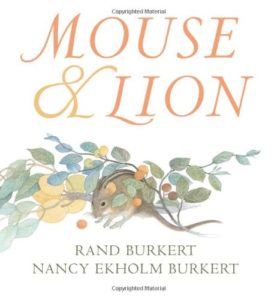
|
Other picture-book takes on Aesop’s tale include Rand Burkert’s Mouse & Lion (Michael di Capua Books, 2011), with enchanting illustrations by Nancy Ekholm Burkert; Bernadette Watts’s The Lion and the Mouse (North-South Books, 2007), in which the mouse first meets the lion as a furry little cub; and Rebecca Emberley’s The Lion and the Mice (Holiday House, 2011) in which a pair of city mice, gorgeously tricked out for a night on the town, encounter the lion in a cage at the zoo. |
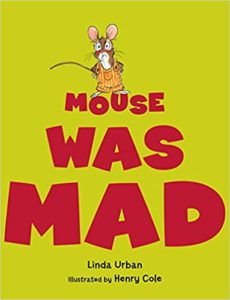
|
Mouse Was Mad by Linda Urban (Harcourt Children’s Books, 2009) is an inspired mouse-based antidote for temper tantrums. Mouse is hopping, stomping, screaming, rolling-around-on-the-ground mad – but he just can’t seem to do mad right. (“Stomping, done right, should result in the shaking of trees and the rumbling of earth,” said Bear.) Finally Mouse discovers that his best way to cope with being mad is to stand very very still – and when he does, he begins to feel better. For angry kids ages 3-6. |
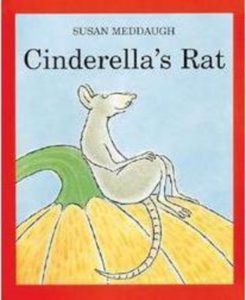
|
The narrator of Susan Meddaugh’s Cinderella’s Rat (Sandpiper, 2002) is an ordinary rat (“I was born a rat. I expected to be a rat all my days. But life is full of surprises.”). Then he and his sister Ruth, out foraging for food, are caught in a rat trap. Released by Cinderella’s fairy godmother, he’s turned into a coachboy, though Ruth remains a rat. At the Prince’s castle, a confused wizard – convinced that Ruth is a human turned into a rat by a magic spell – does his best to reverse the damage. A fun fractured fairy-tale for ages 4-8. |
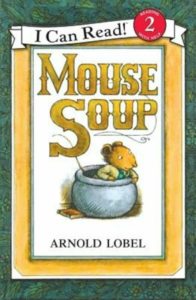
|
In Arnold Lobel’s Mouse Soup(HarperCollins, 1983), a quick-thinking mouse, captured by a hungry (but gullible) weasel, manages to trick his way out of the soup pot by telling four clever stories. For ages 4-7. Also see Lobel’s Mouse Tales (HarperCollins, 1978), in which a mouse father tells seven short funny stories, one for each of his seven little sons. |
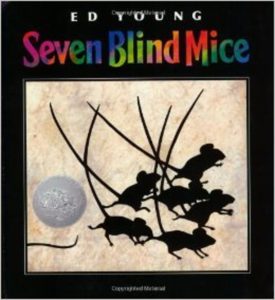
|
Seven Blind Mice by Ed Young (Puffin, 2002) is a mouse-ish version of the old Indian tale of the blind men and the elephant. Seven differently colored mouse approach a mysterious – well, something – by the local pond, and each brings back a different impression of it. Only when the seventh mouse ties all their stories together does the conclusion become clear. Moral: “Knowing in part may make a fine tale, but wisdom comes from seeing the whole.” For ages 4-8. |
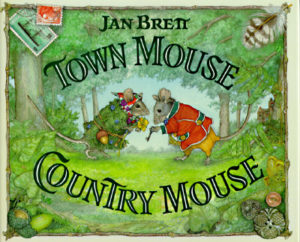
|
In Jan Brett’s Town Mouse, Country Mouse (Puffin, 2003), a take on Aesop’s familiar fable, the town mice – who live in a lush Victorian townhouse – swap places with the country mice, who live in a tree stump. Both pairs struggle with new and unfamiliar surroundings and finally conclude that they’d rather be home. For ages 4-8. |
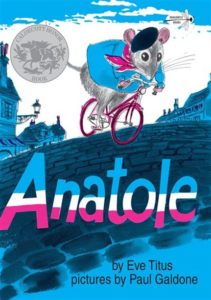
|
The title character of Eve Titus’s Anatole (Dragonfly Books, 2010) is a talented gourmet mouse, who wears a beret and rides a bicycle. Struggling to find a way to feed his family, he begins to critique the cheeses of the Duvall Cheese Factory – where his recommendations are so spot-on and helpful that he becomes the factory’s official (though mysteriously never seen) cheese taster. Pair this one with a homestyle cheese tasting. For ages 4-8. |
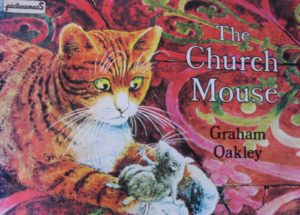
|
Graham Oakley’s The Church Mouse (Aladdin Books, 1972) can take a bit of effort to track down, but it’s well worth it. This is the first of a series of wonderful British picture books featuring Arthur, the church mouse, Sampson, the long-suffering church cat, and a delightful cast of mouse and human characters. Clever, tongue-in-cheek, and hilarious. For ages 5 and up. |

|
In Beverly Cleary’s The Mouse and the Motorcycle (HarperCollins, 1990), Ralph (the mouse) discovers the (toy) motorcycle in a hotel room – and promptly drives it off the bedside table and into a wastebasket. Rescued by Keith, the motorcycle’s owner, Ralph soon learns to ride – including the trick of starting the motorcycle by making a special noise (p-p-b-b-b-b). Adventures and disasters ensue – themes of the book are friendship, trust, and responsibility – and ultimately Keith generously gives Ralph the motorcycle (and a crash helmet) for his very own. Sequels include Runaway Ralph and Ralph S. Mouse. For ages 5-9. |
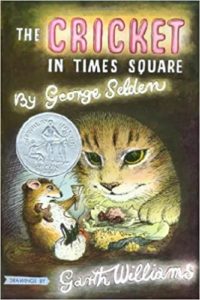 |
George Selden’s Cricket in Times Square (Farrar, Straus & Giroux, 1960) features not only a very talented cricket, but Tucker, a cool NYC mouse, and his friend Harry the Cat. For ages 6-9. |
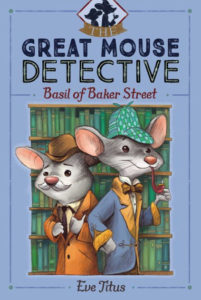 |
Eve Titus’s Basil of Baker Street (Aladdin, 2016) is the first of a series starring mouse sleuth Basil, who lives in the basement of Sherlock Holmes’s house at 221B Baker Street and is a disciple of the great detective. His first case: the Mystery of the Missing Twins. For ages 6-9. |
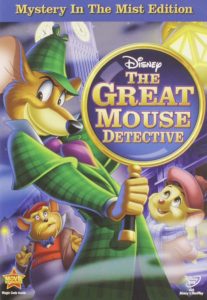 |
Disney’s The Great Mouse Detective (1986) is based on the adventures of Basil, the rodent Sherlock Holmes. Rated G. |
| For many more resources, see Mysteries. | |
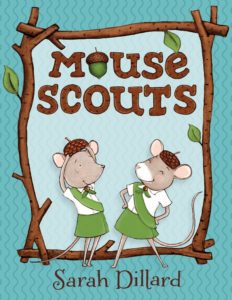
|
In Sarah Dillard’s Mouse Scouts (Yearling, 2016), first of the Mouse Scouts series, the new scouts – Violet, Tigerlily, Hyacinth, Petunia, Junebug, and Cricket – tackle their first merit badge, which involves planting a vegetable garden. Each book includes pages from the Mouse Scout Handbook, diagrams, games, and activities. For ages 7-10. |
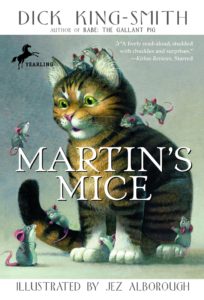
|
The Martin of Dick King-Smith’s Martin’s Mice (Yearling, 1998) is a cat. Martin befriends mice – for which he gets a lot of grief from the other cats and kittens – and eventually, secretly, he even captures a mouse to keep as a pet. When his mouse, Drusilla, escapes, Martin is dismayed – until his own experience of being a captive housepet gives him some perspective. Discussion topics include respect, differences, and the nature of freedom. For ages 7-11. |
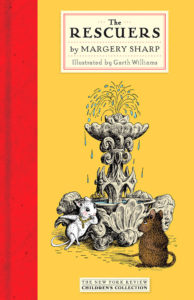
|
Margery Sharp’s The Rescuers (NYR Collection, 2011), originally written in 1959, has recently been beautifully re-issued as part of the New York Review of Books Children’s Collection. The story: the Prisoner’s Aid Society – the mouse version of Amnesty International – wants to rescue a Norwegian poet from imprisonment in fearsome Black Castle. To that end, Bernard (brave brown mouse) is dispatched to engage the services of the brilliant, beautiful, and Norwegian-speaking Miss Bianca (affected white mouse), who lives in a porcelain pagoda at the home of the Ambassador, eats cream cheese from a bonbon dish, and wears a silver chain around her neck. A mouse-style political thriller for kids. For ages 7-11. |
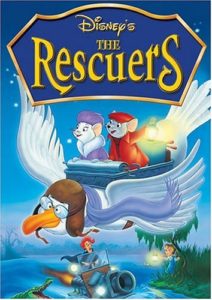 |
In the Disney version of The Rescuers (1977), Bernard and Bianca – members of an organization quartered in the basement of the United Nations building – set out to rescue Penny, an orphan who has been kidnapped by evil pawnshop owner Madame Medusa. The plot involves a trip to Devil’s Bayou, a quest for the world’s largest diamond, and a pair of ferocious pet alligators. Rated G. |
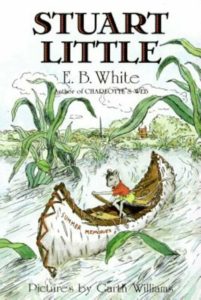
|
Mr. and Mrs. Little’s second son – and the protagonist of E.B. White’s classic, Stuart Little (Harper & Row, 1974) – is a mouse. His parents, unfazed, make their unusual child a bed from four clothespins and a cigarette box, and Stuart soon grows up to be an adventurous and personality-laden mouse, capable of tackling everything from a sailing race to the machinations of the family cat. Still, the cat succeeds in frightening away Stuart’s beloved bird friend, Margalo – and, now grown up, Stuart sets off on a quest to find her. The book ends there, with Stuart still looking, journeying hopefully. It’s a wonderful story and a great discussion-promoter. For ages 7-11. |
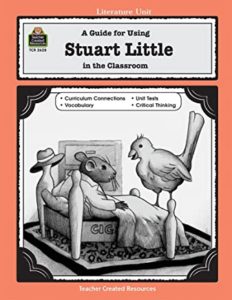 |
A Guide for Using Stuart Little in the Classroom by Lorraine Kujawa and Virginia Wiseman (Teacher Created Materials, 2004) has quizzes, hands-on projects, and curriculum connections. |
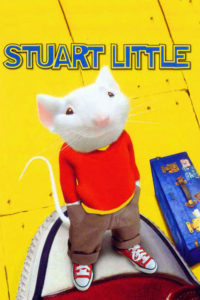 |
In Stuart Little (1999), the Little family adopts the mouse – which solves a lot of biological questions that are bound to pop up from the book. The plot involves a pair of imposter mice, claiming to be Stuart’s real parents, a kidnapping, and some murderous alley cats. Rated PG.
|
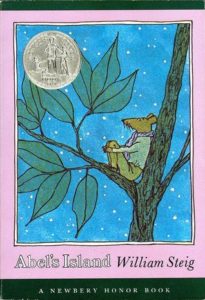
|
Abel, of William Stieg’s Abel’s Island (Square Fish, 2007), a wealthy, pampered, and sophisticated mouse (think quail eggs and croquet), is swept away from his wife Amanda by a hurricane. Stranded on an island, Abel struggles to survive and to find his way back home. He ends up spending a year as a castaway, during which he learns a great deal about himself, his place in the universe, and the nature of life and love. For ages 8-12. |
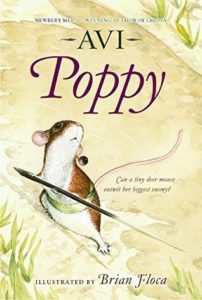
|
In Avi’s Poppy (HarperCollins, 2005), the mice of Dimwood Forest live under the claw of the despotic owl Mr. Ocax, who has forbidden them to move about without his express permission, and who claims – deceitfully – to be protecting them from dangerous porcupines. After Poppy’s boyfriend Ragweed is killed by the owl, Poppy leads the move to relocate the forest mice to a new home – and ultimately, bravely armed with a porcupine quill, defeats Mr. Orax. Several sequels. For ages 8-12. |
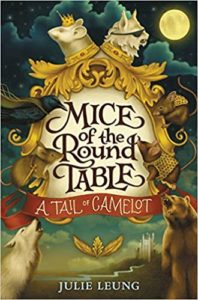 |
Julie Leung’s Mice of the Round Table (HarperCollins, 2017) is the first of an epic series based on Arthurian legend. With mice. For ages 8-12. |
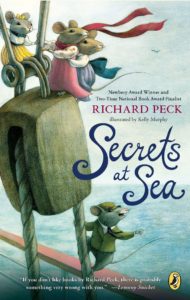
|
Richard Peck’s Secrets at Sea (Dial, 2011) is a tale of two Victorian-era families: the Upstairs Cranstons, humans with daughters Olive and Camilla, and the Downstairs Cranstons, a family of mice – Helena, Louise, flighty Beatrice, and little brother Lamont – who live inside the Cranston house walls. When the upstairs family embarks for Europe to find Olive a husband, the mice naturally go along. On the voyage they meet the ship’s complement of traveling mice – among them the Duchess of Cheddar Gorge, Mouse-in-Waiting to Queen Victoria’s fourth daughter, the elegant Lord Peter, Mouse Equerry to Lord Henshowe, and the handsome Nigel, the ship’s mouse steward. A delightful Borrowers-style story, filled with adventure, humor, and romance. For ages 8-12. |
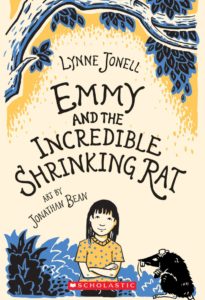
|
In Lynne Jonell’s Emmy and the Incredible Shrinking Rat (Henry Holt and Co., 2007), Emmy’s parents have suddenly become very rich – and they’ve also changed for the worse. Once they just wanted to stay home with Emmy, reading and sailing on the lake; now they’re interested in nothing but travel and parties, and take no notice of Emmy at all. In fact, Emmy, everywhere, is practically invisible. It all seems to be the fault of her new nanny, the nefarious Miss Barmy – but Emmy gets help from an unexpected quarter. Bitten by the class pet rat, she finds that she can understand rat speech – and a second bite, even more remarkably, causes a bitten victim to shrink down to rat size. With the help of Raston the Rat, Joe, Emmy’s soccer-playing best friend, the chipmunks who live under the house, and the remarkable magical rodents of the mysterious Antique Rat shop, Emmy manages to defeat Miss Barmy and bring her parents to their senses. For ages 8-12. Sequels are Emmy and the Home for Troubled Girls and Emmy and the Rats in the Belfry. |
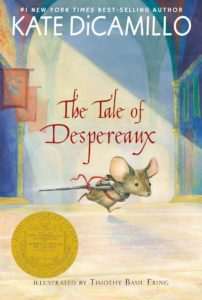
|
In Kate DiCamillo’s Newbery-Medal-winning The Tale of Despereaux(“Being the Story of a Mouse, A Princess, Some Soup, and a Spool of Thread”) (Candlewick, 2006), Despereaux is a little mouse whose ears are too big, whose eyes open too soon, and whose mother’s favorite word is “disappointment.” But Despereaux is a very special mouse: he loves music, loves to read, and very much loves the king’s daughter, Princess Pea. When a conflicted rat and an abused servant girl conspire to kidnap the princess and imprison her in the dungeon, Despereaux saves the day. A multidimensional story in which readers discover that few people (or mice or rats) are all bad or all good. For ages 8-12. |
| This illustrated Teacher’s Guide to The Tale of Despereaux has chapter by chapter summaries, guided reading suggestions, discussion questions, vocabulary lists, and activities. | |
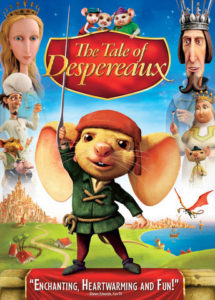 |
The movie version of The Tale of Despereaux (2008) is rated G. |
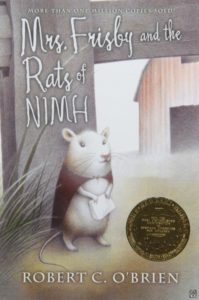
|
Robert C. O’Brien’s Newbery-Medal-winning Mrs. Frisby and the Rats of NIMH (Aladdin, 1986) is the story of a widowed mouse who must relocate her family before spring plowing time, but whose little son Timothy is too sick to be disturbed. For help, she goes to the mysterious rats who live beneath the Fitzgibbon farm rosebush. The rats, escapees from a laboratory at the National Institute of Mental Health (NIMH), were victims of experiments that made them both long-lived and highly intelligent – they can read, write, and build and operate machinery. In return for their aid, Mrs. Frisby is able to do the rats a great service as well, when it turns out that plans are afoot to exterminate the rosebush colony. For ages 8-12. |
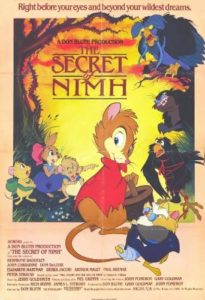 |
The Secret of NIMH (1982) is a wonderful movie version of the book – though Mrs. Frisby’s name has been changed to Brisby to placate makers of frisbees. Rated G. |
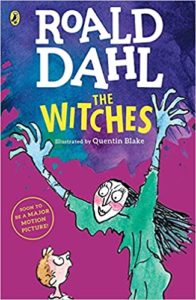 |
In Roald Dahl’s The Witches (Puffin, 2007) – a tale about REAL witches – the fearsome Grand High Witch arrives in England with a plan to turn all the country’s children into mice. For ages 8-12. |
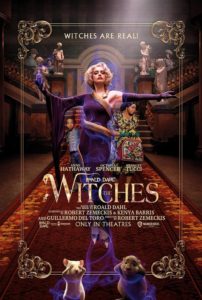 |
The movie version of The Witches (1990) – with Angelica Huston as a truly awful Grand High Witch – is rated PG. |
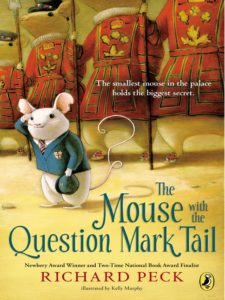
|
In Richard Peck’s The Mouse With the Question Mark Tail (Dial Books, 2013), Mouse Minor has been raised by his Aunt Marigold in the Royal Mews of Buckingham Palace, where he attends the Royal Mews Mouse Academy. Bullied for not knowing his family history, he decides to visit the elderly Queen Victoria, in hopes that she’ll be able to answer some of his questions. For ages 8-12. |
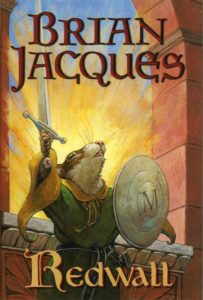
|
In Brian Jacques’s Redwall (Puffin/Philomel, 2002), the peaceful mice of Redwall Abbey are pitted against the evil rat Cluny the Scourge and his hideous horde. To defeat Cluny, Matthias, a brave young mouse, sets out to find the legendary sword of Martin the Warrior, with the help of a wonderful cast of characters, among them Constance the badger, Warbeak Sparra, princess of the sparrow tribe, and the wood-savvy squirrel Silent Sam. There are twenty-two sequels – all exciting – which generally end happily with a post-battle feast of damson pudding. For ages 9 and up. |
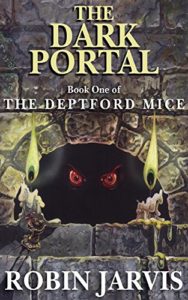
|
Fans of Redwall may also like Robin Jarvis’s Deptford series, beginning with The Dark Portal (Seastar Books, 2000). The Deptford mice live in an old house called Skirtings in the Deptford borough of London, where they lead a peaceful existence worshipping a kindly god known as the Green Mouse. Then mouse Albert Brown vanishes into the sewers, which are inhabited by villainous mouse-eating rats. His daughter Audrey sets out to rescue him, later followed by her brother and companions; and ultimately there’s a showdown between the mice and the demonic Jupiter, Lord of the Rats. Sequels are The Crystal Prison and The Final Reckoning. For ages 9 and up. |
